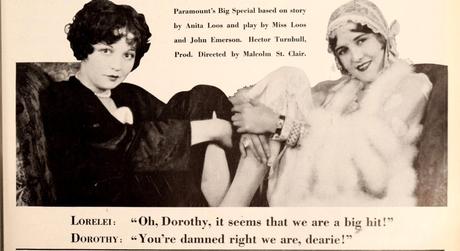
If you mention Gentlemen Prefer Blondes, the first name people will think of is Marilyn Monroe. Or, for musical theater fans, perhaps it’s Carol Channing. But before either of them came to be known as Lorelei Lee, Anita Loos was the name everyone associated with the story.
Anita Loos was inspired to write Gentlemen Prefer Blondes after observing a beautiful blonde woman on a train who had no trouble getting the attention of the men on the train when she dropped her book, while Loos was left to struggle with heavy suitcases on her own. She took this idea and wrote some scenarios about a gold digging blonde named Lorelei Lee, adding in some satire based on how she’d seen magazine editor H.L. Mencken fall all over himself fawning over some Ziegfeld showgirls. Thinking he’d get a kick out of the stories, Loos sent them to Mencken, who took the joke well and forwarded them the editor of Harper’s Bazaar. Harper’s Bazaar liked the stories so much, Loos was asked to write more stories based on this character.
Starting in the spring of 1925, stories of Lorelei Lee started appearing in Harper’s Bazaar and a sensation was born. The stories were turned into a book published later that year, which went on to become the second best selling novel of 1926. The antics of Lorelei Lee were also quickly turned into a comic strip and a stage play. Naturally, it was only a matter of time before a film adaptation would be in the works.
Finding Lorelei Lee
Given how massively successful Gentlemen Prefer Blondes was in print and on the stage, a film adaptation was destined to get a lot of buzz, especially around who would play Lorelei. Since the role would go on to be played by major icons like Carol Channing and Marilyn Monroe, you might expect that the 1928 version would have starred a major icon of the silent screen. Perhaps Clara Bow gone blonde. Instead, the role went to someone who would have little name recognition just a few years later.
The casting process for Gentlemen Prefer Blondes was not unlike what would infamously happen a decade later while casting the role of Scarlett O’Hara in Gone With the Wind. Much of the press surrounding the movie referenced Paramount’s extensive search for the perfect Lorelei Lee. Many big names were considered for the part, including Marion Davies, Constance Talmadge, Dorothy Mackaill, and Phyllis Haver. Fans and publications alike had their opinions about who should land the coveted role. In June 1926, Screenland magazine recommended Esther Ralston as their top choice for Lorelei, but also stated that Laura La Plante, Clara Bow, and Louise Brooks could also be good. In October 1926, Motion Picture Magazine ran an item reporting on rumors that Lillian Gish had landed the part, to which an unnamed hotel clerk is quoted as saying, “If Lillian Gish is to have the lead in Gentlemen Prefer Blondes, I cease to be a gentleman.”
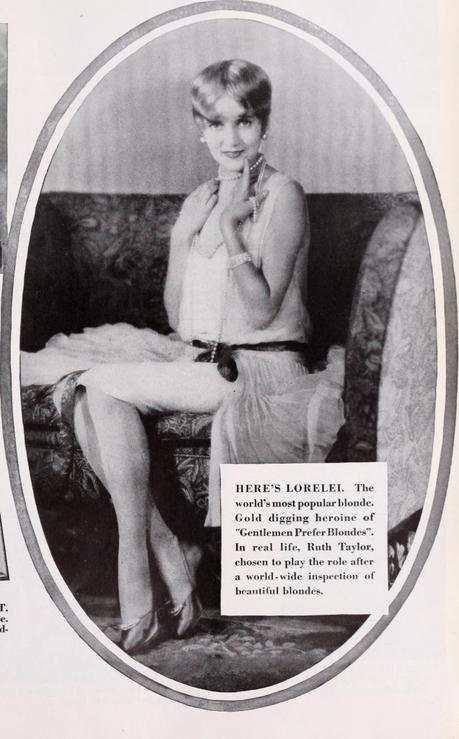
In the end, Lorelei Lee was first played on screen by an actress named Ruth Taylor. As was the case for Gone With the Wind, the highly sought-after leading role ended up going to an actress who was fairly unknown to the American public. Ruth Taylor was born on January 13, 1905 in Grand Rapids, Michigan. Eventually, her family moved to Portland and, eager to start working in films, she later made her way to Hollywood. Once in Hollywood, she got her start working for Mack Sennett, appearing in a series of short films. The films she made for Mack Sennett were often uncredited, but she did get to appear in shorts with Harry Langdon and Billy Bevan.
By the time Gentlemen Prefer Blondes was released in 1928, Ruth Taylor hadn’t appeared in a feature length film before. Anita Loos and husband John Emerson were involved in the casting process and had just about exhausted the casting directories. In an article titled The Search for Lorelei Lee, published in Photoplay‘s November 1927 issue, it’s said that by the time Loos and Emerson met Ruth Taylor, Paramount was threatening to put in one of their own contract players and Loos and Emerson were threatening to tear up their contracts if that happened. (This article also states that one of the top three contenders for the part of Lorelei was future burlesque queen Sally Rand.) Emerson is quoted as saying, “The trouble was that Lorelei requires brains. Lorelei is just as dumb as John D. Rockefeller in an oil field.” But when they finally saw Ruth Taylor, they immediately knew she was exactly what they were looking for — she had the right look and was able to bring the right characterization to the part.
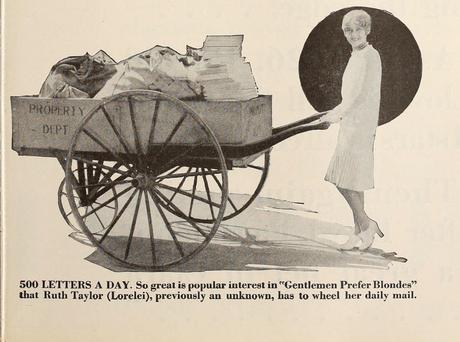
When Ruth Taylor’s casting was announced, the media machine ran with the whole Cinderella story angle. Pictureplay magazine called it “the break of the year” while many other publications played up how this virtually unknown actress had beaten out hundreds of others for one of the biggest roles in Hollywood. In the aforementioned Search for Lorelei Lee article, Photoplay magazine introduces her to their readers by describing her as, “…the kind of girl modern girls will like tremendously. She is chic, charming, sophisticated, and capable.” The fact that she also landed a five-year contract with Paramount along with the role of Lorelei Lee was another frequent talking point in press for the movie. Shortly after Gentlemen Prefer Blondes was released, Taylor was part of the group of up-and-coming stars named WAMPAS Baby Stars, a group which notably included Lupe Velez, Lina Basquette, and Sally Eilers that same year.
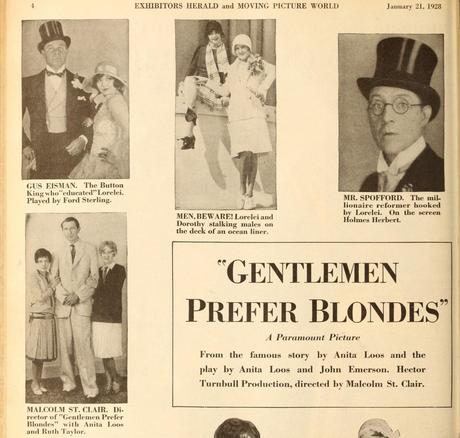
The Movie
In addition to Ruth Taylor, Gentlemen Prefer Blondes also starred Alice White as Dorothy Shaw, Ford Sterling as Gus Eisman, Holmes Herbert as Henry Spoffard, and Mack Swain as Sir Francis Beekman. Plus Anita Loos was not only involved with casting the movie, she and her husband wrote the story and its intertitles. The movie was released on January 18, 1928 and in the time leading up to its release, Paramount promoted it to theater owners as being one of their big special movies of the year, listing it alongside movies like Harold Lloyd’s Speedy, The Last Command with Emil Jannings, Tillie’s Punctured Romance with W.C. Fields, and Beau Sabreur with Gary Cooper.
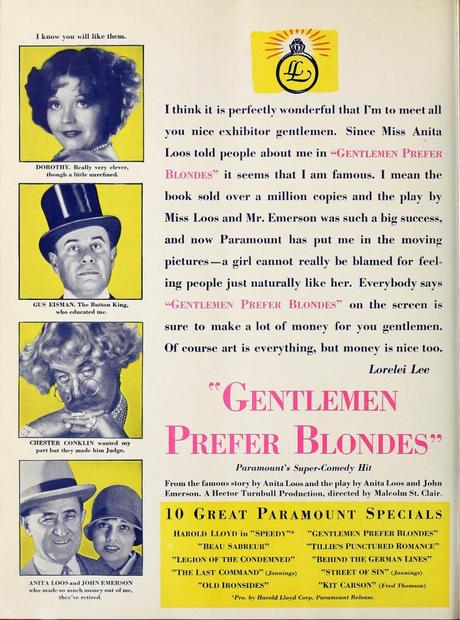

Despite the fact that the movie is now considered to be a lost film, there are some details out there which give clues about how it compared to the source material. One review in the December 10, 1927 issue of The Film Spectator said, “The picture followed the book faithfully, but it didn’t follow it far enough. It stopped just where the book was getting interesting.” In a 1930 publication titled Censored: The Private Life of the Movie, one passage says of Gentlemen Prefer Blondes, “Fortunately for the movie public, the censors cut any suggestions of immorality from it, as you have seen.” In my article comparing the 1953 version of Gentlemen Prefer Blondes to the book, I noted that the tiara Lorelei longs for never belonged to Lady Beekman in the book, but did in both the movie and the stage musical version. Screenland’s review for the 1928 film mentioned Francis Beekman crowning Lorelei with his wife’s tiara, so that’s a change from the source material which pre-dates both the Marilyn Monroe and Carol Channing versions. The movie also includes credits for Lorelei’s mother and grandmother, but the book mentions Lorelei’s mother had died and a grandmother is never mentioned.
Looking back on the original media coverage for Gentlemen Prefer Blondes, you’ll find some respectable reviews, but the movie seems to have missed the mark on some level. Screenland magazine’s review said of it, it “isn’t the satire some hoped it might be, but it is good entertainment.” One review published in the December 10, 1927 issue of The Film Spectator stated, “There is one thing which can be said of Gentlemen Prefer Blondes: there were very few, if any, mistakes which were due to carelessness. The picture ran pretty smoothly. As a matter of fact, that was in a way what was the matter with it; it ran too smoothly. There were no outstandingly funny scenes and there were no outstandingly good ones. By the same token, there were no outstandingly bad scenes.”
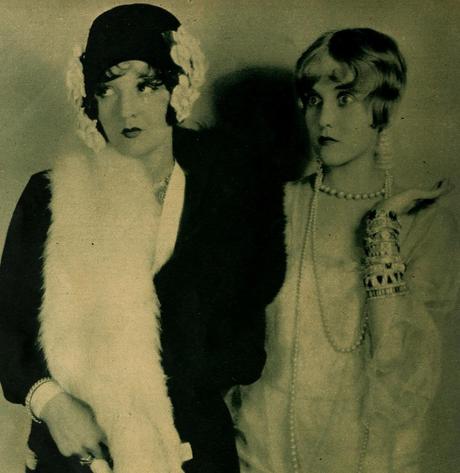
It didn’t take long for the media to start discussing Gentlemen Prefer Blondes in ways that suggests it was something of a then well-known example of a hyped-up movie that fell short. In the September 1929 issue of Picture Play Magazine, a brief mention is made of Ruth Taylor appearing in a play called “Little Orchid Annie” and the writer remarks that based on her performance, she probably would have been a great Lorelei on stage or in a talkie version of Gentlemen Prefer Blondes, ending with the note, “Gentlemen Prefer Blondes, as you know, didn’t register as a silent film.” In August 1930, Photoplay magazine published an article titled Flashing in the Pan, which stated Gentlemen Prefer Blondes didn’t work for multiple reasons, chief among them was that the story was too well known and there had already been many trite imitations of Lorelei Lee. The author also notes that Ruth Taylor unfairly got a lot of blame for movie not being as successful as hoped.
Going through those original reviews, Ruth Taylor’s performance does get a lot of good notes. Generally, she was praised for being an excellent Lorelei, but some critics had reservations about her long-term prospects as a leading lady. The December 10, 1927 issue of The Film Spectator features a rather lengthy review of the movie in which the author cites weak direction from Malcolm St. Clair and writing that lacked the nuance of the original book, but lauds Ruth Taylor for carrying the movie. This author calls her the perfect Lorelei Lee, but also states they would be surprised if she were to develop the range of Janet Gaynor or Dolores del Rio. In the February 18, 1928 issue of Exhibitors Herald and Moving Picture World, the following is written about Ruth Taylor’s performance in Gentlemen Prefer Blondes:
“The publicity about the new young lady who gets the big break in the thing may or may not have good foundation, but the kid has the stuff for this thing at least…If I had to make books on her I’d say the role would kill her in other things (like Peter Pan all but killed Betty Bronson), but I don’t have to make books. I simply raise the point in order to to suggest that Miss Loos use her influence to keep the girl in Anita Loos projects, even if it means dashing off a series of them.”
Even if the movie didn’t meet initial expectations, it would still be very exciting news if a print were to be discovered. Given how actively involved Anita Loos was with its production, it would be a very significant find. As beloved as the Marilyn Monroe version of the movie is, it’s hard not to be intrigued by what Ruth Taylor’s performance as Lorelei Lee was like, given all those remarks about her being perfect for the part. It would also be the only film version of the story (thus far) which seems to have stayed faithful to its wildly popular source material.
What Ever Happened to Ruth Taylor?
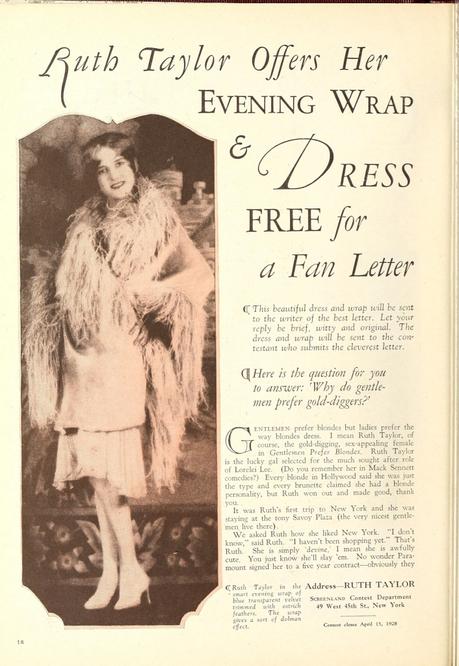
Despite all the buzz around the five-year contract Ruth Taylor signed after being cast as Lorelei Lee, her Hollywood career would be over in less than five years. The May 5, 1928 issue of Exhibitors Herald and Moving Picture World contained an announcement that Ruth Taylor would be appearing with James Hall, who’d had his breakout moment a few years earlier in The Campus Flirt with Bebe Daniels, in a series of three comedy melodramas. Taylor and Hall would end up making just one movie together, 1928’s Just Married. Taylor also starred in 1929’s The College Coquette, but that is the last feature she made where she was the top-billed star. That same year, she also appeared in This Thing Called Love, which had Constance Bennett and Edmund Lowe as the top stars. She also appeared in two short films, 1929’s A Hint for Brides and 1930’s Scrappily Married.
By 1929, Ruth Taylor’s sudden rise to stardom was already being used as a cautionary tale of how damaging too much hype too soon can be. The April 1929 issue of Photoplay featured an article titled Don’t Be Discovered, which notes, “Her failure to live up to predictions in Gentlemen Prefer Blondes is perhaps the obstacle that blocked her road to fame. A case, no doubt, of too much publicity, too much ballyhoo. Only the miracle of a phenomenal performance can raise her now from the leading lady ruck, a position from which there is, for many, no direction to bow but out.”
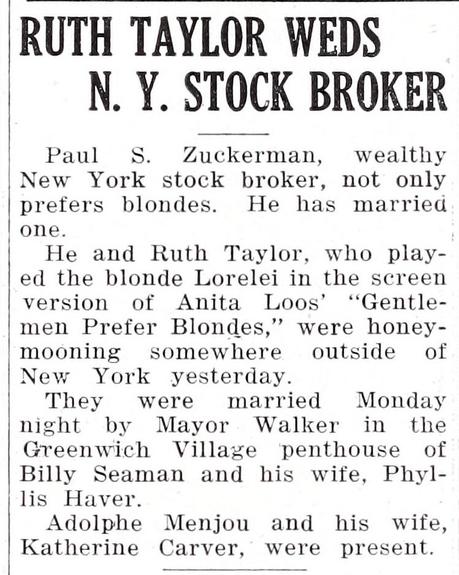
At some point, Ruth Taylor went to New York to work on the stage and while she was there, she met Paul Zuckerman, a stockbroker and former aviator, at a party. It turned into a whirlwind romance and they were engaged weeks later, marrying on March 17, 1930. News of her marriage resulted in the press making many jokes along the lines of, “here’s one gentlemen who clearly prefers blondes,” with a few jokes in the mix about art imitating life since the actress famous for playing a gold digger ended up marrying a stockbroker.
Ruth Taylor’s career as an actress essentially came to an end after her wedding. Her last credited role after that was in a single episode of the TV series Trapped in 1950. While her career in Hollywood was short-lived, she created a legacy that would be very influential in Hollywood decades later. Her son, Buck Henry, had a notable acting career of his own, ranging from The Graduate and Heaven Can Wait to 30 Rock and Hot in Cleveland, as well as earning writing credits for The Graduate and What’s Up Doc?
